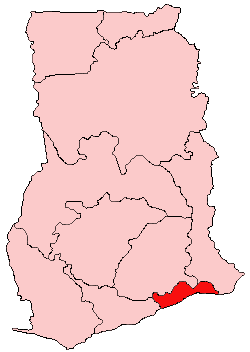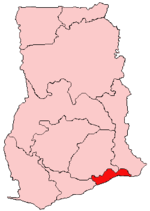
Accra is the capital and largest city of Ghana, located on the southern coast at the Gulf of Guinea, which is part of the Atlantic Ocean. As of 2021 census, the Accra Metropolitan District, 20.4 km2 (7.9 sq mi), had a population of 284,124 inhabitants, and the larger Greater Accra Region, 3,245 km2 (1,253 sq mi), had a population of 5,455,692 inhabitants. In common usage, the name "Accra" often refers to the territory of the Accra Metropolitan District as it existed before 2008, when it covered 199.4 km2 (77.0 sq mi). This territory has since been split into 13 local government districts: 12 independent municipal districts and the reduced Accra Metropolitan District (20.4 km2), which is the only district within the capital to be granted city status. This territory of 199.4 km2 contained 1,782,150 inhabitants at the 2021 census, and serves as the capital of Ghana, while the district under the jurisdiction of the Accra Metropolitan Assembly proper (20.4 km2) is distinguished from the rest of the capital as the "City of Accra".
The Dangme language, also Dangme or Adaŋgbi, is a Kwa language spoken in south-eastern Ghana by the Dangme People (Dangmeli). The Dangmeli are part of the larger Ga-Dangme ethnic group. Klogbi is a variant, spoken by the Kloli. Kropp Dakubu (1987) is the most thorough grammar of the language.

Tema is a city on the Bight of Benin and Atlantic coast of Ghana. It is located 25 kilometres (16 mi) east of the capital city; Accra, in the region of Greater Accra, and is the capital of the Tema Metropolitan District. As of 2013, Tema is the eleventh most populous settlement in Ghana, with a population of approximately 161,612 people – a marked decrease from its 2005 figure of 209,000. The Greenwich Meridian passes directly through the city. Tema is locally nicknamed the "Harbour City" because of its status as Ghana's largest seaport. It consists of 25 different communities which are numbered accordingly with each of them having easy access to the basic amenities.
The Ga-Dangbe, Ga-Dangme, Ga-Adangme or GaDangme are an ethnic group in Ghana, Togo and Benin. The Ga and Dangbe people are grouped respectively as part of the Ga–Dangme ethnolinguistic group. The Ga-Dangmes are one ethnic group that lives primarily in the Greater Accra region of Ghana. Ethnic Ga family names (surnames) include Nikoi, Amon, Kotey, Kotei, Adei, Adjei, Kutorkor, Oblitey, Lartey, Nortey, Aryee, Obodai, Oboshi, Torgbor, Torshii and Lante. The following are names derived from the ethnic Dangme and common among the Ningos Nartey, Tetteh, Kwei, Kweinor, Kwetey, Narteh, Narh, Dugbatey, Teye, Martey, Addo, Siaw, Saki, Amanor, Djangba. These are aligned to the ethnic Ga as well: Lomo, Lomotey, Tetteh, Ankrah, Tetteyfio, Laryea, Ayitey, Okai, Bortey, Quaye, Quaynor, Ashong, Kotei, Sowah, Odoi, Ablor, Adjetey, Dodoo, Darku and Quartey.

Teshie is a coastal town in the Ledzokuku Municipal District, a district in the Greater Accra Region of southeastern Ghana. Teshie is the ninth most populous settlement in Ghana, with a population of 171,875 people.

The Accra Metropolitan District is one of the 254 Metropolitan, Municipal and Districts in Ghana, and among the 26 such districts in the Greater Accra Region with a population of 284,124 as of 2021. As of March 2018, it spans an area of approximately 60 km2 (23 sq mi) and encompasses the Ablekuma South, Ashiedu Keteke, and Okaikoi South sub-metropolitan district councils.

Dangme East District is a former district that was located in Greater Accra Region, Ghana. Originally created as an ordinary district assembly in 1988, which was created from the former Dangme District Council. However on 28 June 2012, it was split off into two new districts: Ada East District and Ada West District. The district assembly was located in the eastern part of Greater Accra Region and had Ada Foah as its capital town.

Ghana is a multilingual country in which about eighty languages are spoken. Of these, English, which was inherited from the colonial era, is the official language and lingua franca. Of the languages indigenous to Ghana, Akan is the most widely spoken in the south. Dagbani is most widely spoken in the north.
Articles related to Ghana include:

The Roman Catholic Archdiocese of Accra covers the Greater Accra Region and parts of the Volta Region. There are 62 parishes and rectories. The Roman Catholic Archdiocese of Accra is the Metropolitan See for the ecclesiastical province of Accra in Ghana which includes the suffragan dioceses of Ho, Koforidua, Jasikan and Keta-Akatsi. The Latin title of the archdiocese is Archidioecesis Accraënsis, and the corporate title is Archdiocese of Accra. The cathedral parish for the archdiocese is the Holy Spirit Cathedral.
Sakumono is a small town before Nungua from Ashaiman. It is in the Tema Metropolitan district, a district in the Greater Accra Region of Ghana. It was originally a small fishing village on Sakumono Lagoon, but by 2008 was being swallowed up as the twin cities of Nungua and Tema were merging. Its elevation is 71m. Sakumono, also known as Community 13, is one of the interesting towns in the area, with the main township being close to the beach and the lagoon. It also has several sectors of Estate buildings and jurisdiction.
Pokuase, also spelled Pokoasi, is a suburb of Accra, the capital city of Ghana and spans the area from Pokuase, leading off the Accra-Kumasi motorway on the right coming from Accra central; and leading off the motorway at Pokuase Junction and rising to ‘Okai Kwei Hill’, on the left coming from town. It is a mixture of lively retail shopping areas, with local stores, bars or 'drinking spots', bus/taxi stations, and a market. It also has many hotels, guest houses and rental apartments- such as the eco-chic Legassi Gardens Apartments-, and 'high-end' developing residential estates, such as Ofankor Hills Estates and Franko Estates, amongst many others; as well as the long-established executive gated community of ACP Estates.; and HFS Estates which borders the erstwhile Gua Koo Sacred Grove in Pokuase.
Nungua is a town in Krowor Municipal District in the Greater Accra Region of southeastern Ghana near the coast. Nungua is the eighteenth most populous settlement in Ghana, in terms of population, with a population of 84,119 people.

Ledzokuku-Krowor Municipal District is a former district that was located in Greater Accra Region, Ghana. Originally it was formerly part of Accra Metropolitan District in 1988, until the far eastern portion of the district was split off to create Ledzokuku-Krowor Municipal District on 1 November 2007 ; thus the remaining part has been retained as Accra Metropolitan District. However on 15 March 2018, it was split off into two new municipal districts: Ledzokuku Municipal District and Krowor Municipal District. The municipality was located in the central part of Greater Accra Region and had Teshie-Nungua as its capital town.

Old Ningo is a town in the Greater Accra Region of Ghana.
The Universal Merchant Bank, formerly known as Merchant Bank Ghana Limited, is a Ghanaian financial institution headquartered in Accra.

The Krobo people are an ethnic group in Ghana. They are grouped as part of Ga-Adangbe ethnolinguistic group and they are also the largest group of the seven Dangme ethnic groups of Southeastern Ghana. The Krobo are a farming people who occupy Accra Plains, Akuapem Mountains and the Afram Basin.
Daniel Nii Kwartei Titus Glover is a Ghanaian politician and the Member of Parliament of Tema East constituency. He is a member of the New Patriotic Party and the Deputy Minister of Transport in Ghana.

Weija Gbawe Municipal District is one of the twenty-nine districts in Greater Accra Region, Ghana. Originally it was formerly part of the then-larger Ga West District in 2004, until the western part of the district was split off to create the first Ga South Municipal District on 29 February 2008, with Weija as its capital town; thus the remaining part was elevated to municipal district assembly status to become Ga West Municipal District. Later, a small portion of the district was split off to create Ga Central Municipal District on 28 June 2012; thus the remaining part has been retained as Ga South Municipal District. However on 15 March 2018, the northern part of the district was split off to create a new Ga South Municipal District, with Ngleshie Amanfro as its capital town; thus the remaining part has been renamed as Weija Gbawe Municipal District, with Weija as its capital town. The municipality is located in the western part of Greater Accra Region and has Weija as its capital town.











